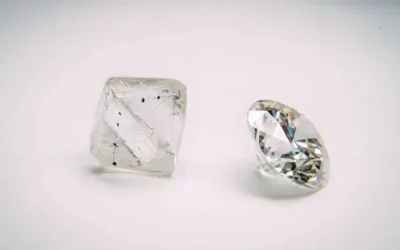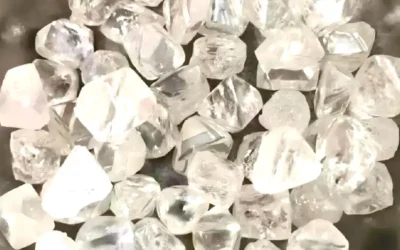Diamonds are often celebrated for their brilliance and dazzling sparkle, but did you know that their journey begins as something entirely different? Raw diamonds are far from the glittering gems we see in jewelry stores. Instead, they’re rough, unpolished, and filled with hidden potential. Understanding what raw diamonds look like can help you appreciate these gems in their natural form, before they’re transformed into the masterpieces we adore.
In this article, we’ll take you through the appearance of raw diamonds, how they’re found, and what makes them so valuable. Whether you’re a diamond lover, a prospective investor, or just someone curious about how raw diamonds become the stunning stones we know, this guide is for you.
1. What Are Raw Diamonds?
Before we dive into their appearance, let’s first define what raw diamonds are. Raw diamonds, also known as uncut or rough diamonds, are the natural form of diamonds that have been extracted directly from the earth. They’ve undergone little to no processing and are typically sold as they are, often with a dull, rough exterior.
Raw Diamonds vs. Polished Diamonds
While polished diamonds are the familiar, sparkling gems that are carefully cut and shaped by skilled artisans, raw diamonds are simply diamonds in their natural state. Raw diamonds come with a matte surface and are not faceted, meaning they lack the shiny, multi-faceted shine we’re accustomed to. It’s only after they’re cut and polished that raw diamonds reveal their true brilliance.
The Diamond Formation Process
Diamonds are formed under extreme pressure and heat deep within the Earth’s mantle, typically 90 to 120 miles below the surface. Over millions of years, carbon atoms bond to form the crystalline structure we recognize as diamonds. Once the diamonds have been brought to the surface through volcanic eruptions, they’re mined, often looking nothing like the gleaming gems they’ll eventually become.
2. How Raw Diamonds Are Found
Finding raw diamonds is no small feat. These precious gems are located deep within the Earth’s crust, often in kimberlite pipes—volcanic formations that act as natural conduits for diamonds. Raw diamonds can also be found in alluvial deposits, which are rivers and streams that have carried diamonds from their original source.
The Mining Process
Diamonds are extracted through a variety of methods, including traditional open-pit mining, underground mining, and even ocean mining. Once they’re dug up, they’re carefully sorted through, with only the rough diamonds being kept. It’s a process that involves a lot of patience and precision.
Locations Around the World
While diamonds can be found in many parts of the world, some countries are known for their significant diamond production. These include South Africa, Russia, Canada, and Australia, which are some of the leading sources of raw diamonds. Additionally, there are regions like Botswana and the Democratic Republic of Congo that are also known for their diamond deposits.
3. The Appearance of Raw Diamonds
So, what exactly do raw diamonds look like? Let’s take a closer look at the physical characteristics that define raw diamonds.
Color: Dull and Natural
When you look at a raw diamond, you won’t see the sparkling white stone you might expect. Instead, raw diamonds often appear dull, cloudy, or opaque. They can be colorless or come in shades of yellow, brown, and even rare hues like pink and blue. The color of a raw diamond is influenced by the impurities and elements trapped inside the crystal as it forms.
The color of raw diamonds is one of the most important factors in determining their value. Generally, diamonds that are colorless or near colorless are considered more valuable, while those with noticeable yellow or brown tints may be less so. However, some buyers specifically seek out raw diamonds with unique colors, as these can be used to create stunning, one-of-a-kind jewelry pieces.
Shape: Rough and Irregular
Raw diamonds aren’t shaped like the perfect, polished stones you see in rings and necklaces. Instead, they typically have irregular and rough shapes. Most raw diamonds naturally form in one of two common crystal structures: octahedral or dodecahedral. These shapes are often angular, with sharp edges that can be deceptive when you first see them.
In their raw state, diamonds may also have a coating of graphite or other minerals on their surface, which adds to their rough appearance. This outer layer is a natural part of their formation and often contributes to their unique look.
Surface Texture: Rough and Matte
The surface of a raw diamond is far from smooth. In fact, it’s usually rough and pitted, with many crystals appearing matte or cloudy. This roughness comes from the natural formation of the diamond within the Earth’s crust, where they’re exposed to heat and pressure for millions of years.
Because of this, raw diamonds lack the brilliance that comes from faceting, and they often appear dull and unremarkable to the untrained eye. However, this roughness is what makes them so special—they have the potential to become something extraordinary once they’re cut and polished.
Size and Weight: Variable
Raw diamonds can vary significantly in size and weight. Some are small and lightweight, while others can be impressively large. The size of a raw diamond is one of the factors that affects its value—larger diamonds tend to be rarer and more expensive. However, it’s not just size that matters; the clarity, color, and overall quality of the rough diamond also play a huge role in its worth.
4. Raw Diamond vs. Polished Diamond: Key Differences
It’s important to understand how raw diamonds differ from polished ones, especially if you’re considering purchasing a diamond in its uncut form. The transformation from raw to polished diamond is a delicate and skillful process, and it’s what gives diamonds their sparkling, brilliant appearance.
Visual Comparison
While raw diamonds may look dull and unrefined, polished diamonds are cut and shaped into perfectly faceted stones that gleam and shine. This is thanks to the careful craftsmanship of a diamond cutter, who uses specialized tools to carefully slice the diamond into a shape that maximizes its brilliance. The polishing process brings out the clarity, color, and sparkle that we associate with diamonds.
The Transformation Process
The process of turning a raw diamond into a polished gem involves several steps:
- Cutting: The diamond is cut into specific shapes, such as round, oval, or princess cut, to enhance its visual appeal. This requires skill and precision, as each cut influences the diamond’s light reflection.
- Shaping: After cutting, the diamond is shaped and faceted to ensure the most light enters and reflects within the stone.
- Polishing: Finally, the diamond is polished to remove any remaining rough edges and to give it its iconic shine.
5. Why Raw Diamonds Are So Valuable
You may be wondering why raw diamonds are so valuable if they don’t look like the polished gems you see in jewelry stores. The truth is, raw diamonds hold immense potential. Their value lies in their rarity, the quality of the stone, and the transformation process they undergo.
The Beauty and Rarity of Raw Diamonds
Raw diamonds are prized not only for their natural beauty but also for their rarity. Because they’ve been formed under specific geological conditions, they’re a limited resource. Their natural, unrefined state is what makes them so appealing to certain buyers, who appreciate the rough, rustic look of these stones.
From Rough to Masterpiece
Raw diamonds are also seen as a canvas for creating unique, customized jewelry. Some buyers choose raw diamonds specifically for their potential to be transformed into something one-of-a-kind. These stones offer the opportunity to create engagement rings, necklaces, and other pieces that stand out due to their natural, unpolished appearance.
Investment Potential
For collectors and investors, raw diamonds offer an opportunity to buy a valuable gem that can increase in value once cut and polished. Many raw diamonds appreciate over time, especially if they possess desirable characteristics like color, clarity, and size.
6. How to Identify Raw Diamonds
Spotting a raw diamond can be tricky, especially if you’re unfamiliar with what they look like. However, there are a few visual cues that can help you identify one.
Sparkle and Texture
Despite their dull appearance, raw diamonds still have an innate sparkle, especially when they catch the light at certain angles. Their texture will also be rough, unlike the smooth surface of other minerals like quartz. The shape of the stone can be another giveaway—look for crystals that are angular, often in a rough, jagged shape.
Using Tools for Identification
To accurately identify a raw diamond, you may need to use tools like a magnifying glass or jeweler’s loupe. These tools help you examine the diamond closely to spot any unique characteristics that set it apart from other rough stones.
7. Popular Myths and Misconceptions About Raw Diamonds
There are plenty of myths surrounding raw diamonds, especially because they look so different from the polished gems most people are used to. Here are a few common misconceptions:
- “Raw diamonds are always dirty and unattractive.”
While raw diamonds may look dull or opaque, many have a beauty of their own that’s appreciated by those who love the natural, rustic look. - “Raw diamonds are not valuable.”
Raw diamonds can be just as valuable, if not more so, than polished diamonds, especially if they possess rare characteristics or unique colors.
8. How Raw Diamonds Are Used in Jewelry
Raw diamonds have become increasingly popular in the jewelry world, especially for engagement rings and custom designs. Many people love the idea of a diamond that hasn’t been altered by human hands—something that’s as natural and unique as possible.
Raw Diamond Jewelry Trends
From raw diamond engagement rings to necklaces and bracelets, these stones are making a statement. The trend of raw diamond jewelry has grown in recent years, with people opting for the more natural, uncut aesthetic rather than the traditional, highly-polished look.
9. Buying Raw Diamonds: What to Know
If you’re considering buying a raw diamond, there are a few things to keep in mind. The first step is deciding whether you want a diamond for investment purposes or for personal use, such as creating custom jewelry.
Factors to Consider
When purchasing raw diamonds, consider the size, color, clarity, and shape of the stone. Some buyers prefer larger stones, while others may seek diamonds with unique characteristics or hues. It’s also essential to ensure the diamond is ethically sourced.
Conclusion
Raw diamonds are truly one of nature’s hidden gems, offering both beauty and potential. While they may not sparkle the way polished diamonds do, they hold a unique charm and are prized for their authenticity and raw allure. Whether you’re considering investing in raw diamonds or simply want to appreciate their natural beauty, understanding what they look like helps you recognize the value in these remarkable stones.
If you’re looking to explore raw diamond jewelry or learn more about their potential, remember that each rough diamond tells its own story—a story waiting to be transformed into something extraordinary.






